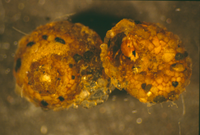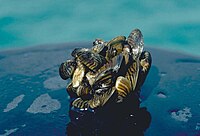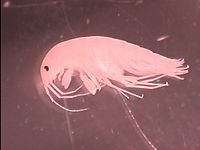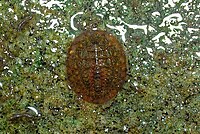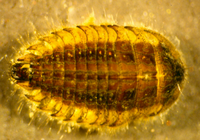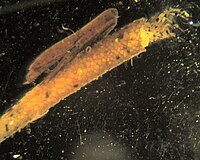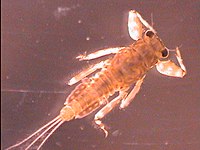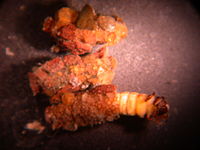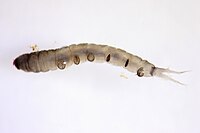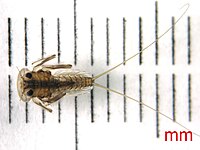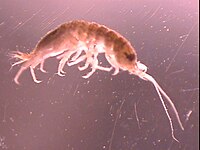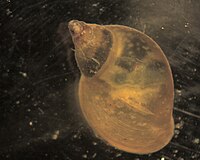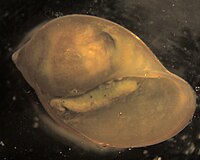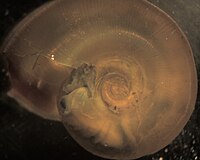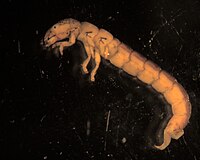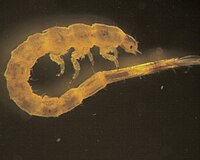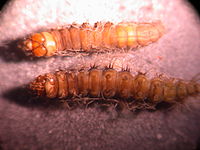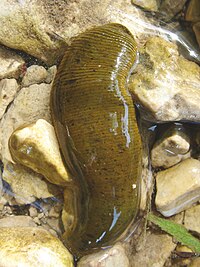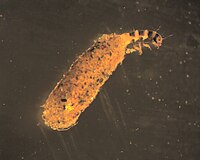Vermont EPSCoR's Streams Project; A Teacher Collaboration on WikiEducator
Openly shared content, practices, and developing resources from Vermont EPSCoR's Streams Project. Join this collaboration and make a difference!
 Lake Champlain at Oakledge Park |
|---|
|
| Basin: | Saint Lawrence |
| State or Province: | Vermont |
| Country: | USA |
| Latitude: | 44.456314 |
| Longitude: | -73.226516 |
| School: | Saint Michael's College |
Oakledge is a public Park in Burlington Vermont. Saint Michael's College students visit the park and sample benthic invertebrates from Lake Champlain as part of a Community Ecology course. We have a fairly comprehensive data set developed over the years yet we frequently find genera that we have not previously sampled. Use the history tab to see what was added this year. is The following are the most common invertebrates collected from this site.
We get two hydroptilid caddisflies at this site. Agraylea often has strands of algae attached. Hydroptila has fine sand grains.
Chironomidae
- Order
- Diptera
- Family
- Chironomidae
- Common name
- Nonbiting midge
- Tied fly
- Griffith's Gnat
Midge larvae tend to be the most common macroinvertebrate at our sites. As with other Diptera, there are no true jointed legs. Chironomidae do have a pair of prolegs at each end and preserved individuals tend to curl into a 'C'. Identification past family requires slide-mounted heads. We have seen philopotamid caddisflies misidentified with the chironomids and we suspect that that happens when samples are being sorted from trays. Under a microscope, six prominent legs can be seen on members of the caddisfly family Philopotamidae.
More information on Philopotamidae.
Hydropsychidae
- Order
- Trichoptera (caddisfly)
- Family
- Hydropsychidae
- Common name
- net spinning caddisfly
- Tied fly
- Emergent Sparkle Pupa, Vermont Hare's Ear
This family of net-spinning caddisflies is very abundant at several sites. They are important filtering collectors and are quite common at urban and agricultural sites where particles of organic material can be important food resources. Genus-level identification is possible for mature specimens and we will include the genera we found at your site if possible.
When using the key, some features that are challenging to see are the forked trochantin and the paired sclerites in the folds between segments. Other, more easily seen key features include filamentous gills on the abdominal segments and the sclerotization of the dorsal surfaces of all three thoracic segments. Keep in mind that with smaller or more immature specimens, genus-level ID may not be possible.
Commonly found genera include Cheumatopsyche, Ceratopsyche, and Hydropsyche. Less commonly, we have found Arctopsyche and Potamyia.
Images of the forked trochantin and the paired sclerites.
Helicopsyche
- Order
- Trichoptera
- Family
- Helicopsychidae
- Genus
- Helicopsyche
- Common name
- snailcase caddisfly
- Tied fly
- speckled peter
This caddisfly genus has one local species. It looks rather like a snail but has lots of sand grains covering it's 'shell' which is really a case. The anal claws have closely-spaced teeth, much like a small comb.
Image of the closely-spaced teeth
Dreissena
- Order
- Veneroida
- Family
- Dreisseniidae
- Genus
- Dreissena
- Common name
- Zebra mussel
Two species in this genus occur in North America: Just the zebra mussel, Dreissena polymorpha occurs in Lake Champlain. Because zebra mussels are invasive exotic species, it is important to ensure that they are not inadvertently moved to other water bodies. Follow the most current DEC guidelines on safe practices when dealing with invasive species. The guidelines currently (last checked Nov 2009) include drying equipment for at least 5 days prior to using elsewhere.
Crangonyx
- Order
- Amphipoda
- Family
- Crangonyctidae
- Genus
- Crangonyx
There is only one genus from Crangonyctidae commonly found in the area. A "scud," or freshwater shrimp, is distinctly flattened side-to-side. These can be confused with Isopoda, which are dorso-ventrally (top to bottom) flattened.
Image of the shrimp flattened side to side.
More information on Isopoda.
Psephenidae
- Order
- Coleoptera
- Family
- Psephenidae
The true "water penny" is commonly found in the waters sampled. Psephenus has a rounded shape with relatively smooth edge. The false water penny, whose edges are serrated, has a more oval appearance. The gills on the ventral surface are found only in the true water pennies.
Ectopria
- Order
- Coleoptera
- Family
- Psephenidae
- Genus
- Ectopria
False water pennies are less circular than true water pennies, and come to a blunt point at the back end. They appear to have serrated edges and lack gills.
Another genus encountered in this family is Psephenus.
Leptoceridae
- Order
- Trichoptera
- Family
- Leptoceridae
- Tied fly
- White Miller, LaFontaine Dancing Caddis
At least two genera from this family are common in Lake Champlain. The species in the genus Nectopsyche that we have found is very long (2.5 cm) and slender. Oecetis cases from our samples are shaped like cornucopia.
Ephemerellidae
- Order
- Ephemeroptera
- Family
- Ephemerellidae
- Common name
- spiny crawler mayflies
- Tied fly
- Blue-Winged Olive
The mayfly
Ephemerellidae is distinguished by the absence of gills on the second abdominal segment; individuals either have gills on segments 3-7 or 4-7. Some may have operculate (plate-like) gills on the fourth segment, though in many the gills are of identical size. The most commonly found genera include
Drunella,
Ephemerella, and
Serratella.
More information on the genera Drunella, Ephemerella, and Serratella.
Neophylax
- Order
- Trichoptera
- Family
- Uenoidae
- Genus
- Neophylax
- Common name
- Fool's Caddis
- Tied fly
- Peeping Caddis
Neophylax are characterized by having a sclerotized pronotum and mesonotum. They build a case of coarse sand grains often with a pair of latteral pebbles or "ballast stones". The larvae are rather stout and the head is scrunched in between the limbs. The anal hooks are attached directly to the abdomen and they rarely come out of the case when preserved. On the ventral surface of the abdominal segments, one can see darkened ovals, known as the chloride epithelia. Like the
Limnephilidae, they have a prosternal horn, though it can sometimes be small. Also, they have a dorsal hump and two lateral humps on the first abdominal segment- be careful! Often times, these features can be
squished down or damaged in the sampling process. A larva removed from it's case is shown
here.
The feature that distinguishes Uenoidae from Limnephilidae is the mesonotum: on either side of the midline, the anterior margin is notched.
Because our samples were taken in summer, we found large numbers of Neophylax pre-pupae. We anticipate that there will be fewer present in the streams in late September and many of those sampled will be at the pupal or adult stage. Samples taken in October would tend to have more empty cases.
Antocha
- Order
- Diptera
- Family
- Tipulidae
- Genus
- Antocha
This small dipteran in the cranefly family is quite common. It is distinguished from most other dipterans we found by the 'creeping welts' that appear as prominent dark stripes along the abdomen. The dark head is usually partly exposed; however, it can be pulled back into the thoracic cavity during preservation.
Heptageniidae
- Order
- Ephemeroptera
- Family
- Heptageniidae
- Common name
- flatheaded mayfly
- Tied fly
- Light Cahill, Wingless Pale Evening Dun
This family of mayflies can be characterized by their distinctly flattened heads and striking resemblance of the character 'Jack Skellington' from the movie 'The Nightmare Before Christmas.' This family can either have two or three cerci (tails).
Commonly encountered genera include:
Epeorus
Heptagenia
Maccaffertium
Rhithrogena
Lirceus
- Order
- Isopoda
- Family
- Asellidae
- Genus
- Lirceus
These aquatic invertebrates are also known as sowbugs. They are flattened top to bottom.
Be sure not to confuse them with the terrestrial sowbugs that can, on occasion, end up in aquatic samples. Terrestrial species have both shorter antennae and legs.
Lymnaeidae
Members of the family Lymnaeidae belong in the class of Gastropoda. Members contain a single, coiled shell with a right-handed spiral. Differing from those of Planorbidae, members of Lymnaeidae have a larger opening. Respiration in these snails are through lung-like structures. Preferred habitats include those with slow streaming waters and heavy vegetation. These right handed snails are somewhat less tolerant of water pollution than our other common snails.
Images of the family Lymnaeidae and the class Gastropoda.
Physidae
Members of the family Physidae belong in the class of Gastropoda. Members contain a single, coiled shell with a left handed spiral going counterclockwise. Belonging to the family of aquatic pulmonates, members breathe air using a structure similar to a lung.
Images of the family Physidae, the class of Gastropodaand a shell with a left-handed spiral.
Planorbidae
- Order
- Basommatophora
- Family
- Planorbidae
- Common name
- Ram's horn snail
Members of the family Planorbidae belong in the class of Gastropoda. The shell of many Planorbidae is flat and dextral, or right-turned. Belonging to the largest family of aquatic pulmonates, members breathe air using a structure similar to a lung.
Images of the family Planorbidaeand class Gastropoda.
Polycentropus
- Order
- Trichoptera
- Family
- Polycentropodidae
- Genus
- Polycentropus
The most common genus we encounter is
Polycentropus. These caseless caddisflies frequently have speckled or freckled heads. The anal proleg typically has a prominent black X, although it can in some specimens appear to be a little faded. They are common at Oakledge Park in Lake Champlain, where we also find an additional genus in the same family:
Nyctiophylax.
Click to see the speckled or freckled heads or the prominent black X.
Dubiraphia
- Order
- Coleoptera
- Family
- Elmidae
- Genus
- Dubiraphia
The larvae of this genus are distinguished by the last abdominal segment, which is very elongated. Adults of this genus usually have prominent longitudinal markings on their elytra and, like adult
Optioservus, have a fringe of tomentum on their anterior tibia.
Image of the fringe of tomentum.
Pyralidae
- Order
- Lepidoptera
- Family
- Pyralidae
Hirudinea
Leeches have bodies with 20 or more segments and a ventral suction disk on at least one end, though sometimes on both ends. They are segmented worms (Phylum Annelida) in the Class Hirudinea. Most of the leeches we sample come from ponds and lakes but they are also commonly found in streams.
Image of the ventral suction disk.
Hydroptilidae
- Order
- Trichoptera
- Family
- Hydroptilidae
- Common name
- micro caddisflies
Members of this family, commonly called micro-caddisflies are typically found in soft pouch-like cases made of silk. As the common name suggests, they are tiny, but have rather bulbous abdomens. Like the Hydropsychidae, the dorsa all three thoracic segments are sclerotized. Unlike them, however, they have no filamentous gills on their abdomens.
Hydroptila is the most common genus we encounter. A close up image can be seen here and click here for more information onHydropsychidae.


